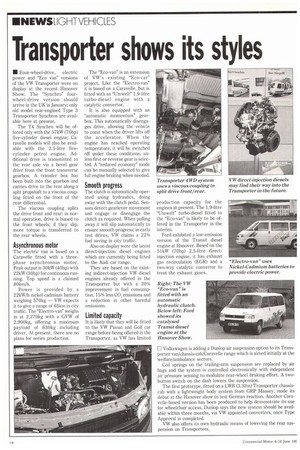Transporter shows its styles
Page 20

If you've noticed an error in this article please click here to report it so we can fix it.
II Four-wheel-drive, electric power and "Eco van" versions of the VW Transporter were on display at the recent Hanover Show. The "Synchro" fourwheel-drive version should arrive in the UK in January; only old model rear-engined Type 3 Transporter Synchros are available here at present.
The T4 Synchro will be offered only with the 57kW (76hp) five-cylinder diesel engine; Caravelle models will also be available with the 2.5-litre fivecylinder petrol engine. Additional drive is transmitted to the rear axle via a bevel gear drive from the front transverse gearbox. A transfer box has been built into the gearbox and carries drive to the rear along a split propshaft to a viscous coupling fitted on the front of the rear differential.
The viscous coupling splits the drive front and rear: in normal operation, drive is biased to the front wheels; if they slip, more torque is transferred to the rear wheels.
Asynchronous motor
The electric van is based on a Caravelle fitted with a threephase asynchronous motor. Peak output is 30kW (40hp) with 22kW (30hp) for continuous running. Top speed is a claimed 80km/h.
Power is provided by a 22kW/h nickel-cadmium battery weighing 570kg — VW expects it to give a range of 65km in city traffic. The "Electro-van" weighs in at 2,270kg with a GVW of 2,900kg, offering a maximum payload of 630kg including driver. At present, there are no plans for series production. The "Eco-van" is an extension of VW's existing "Eco-car" project. Like the "Electro-van" it is based on a Caravelle, but is fitted with an "Umwelt" 1.9-litre turbo-diesel engine with a catalytic convertor.
It is also equipped with an "automatic momentum". gearbox. This automatically disengages drive, allowing the vehicle to coast when the driver lifts off the accelerator. When the engine has reached operating temperature, it will be switched off under these conditions, unless first or reverse gear is selected. A "reduced economy" mode can be manually selected to give full engine braking when needed.
Smooth progress The clutch is automatically operated using hydraulics, doing away with the clutch pedal. Sensors detect gearlever movement and engage or disengage the clutch as required. When pulling away it will slip automatically to ensure smooth progress; in early test drives, VW claims a 22% fuel saving in city traffic.
Also on display were the latest direct-injection diesel engines which are currently being fitted to the Audi car range.
They are based on the existing indirect-injection VW diesel engines already offered in the Transporter but with a 20% improvement in fuel consumption, 15% less CO, emissions and a reduction in other harmful emissions.
Limited capacity
It is likely that they will be fitted to the VW Passat and Golf car range before being offered in the Transporter, as VW has limited production capacity for the engines at present. The 1.9-litre "Umwelt" turbo-diesel fitted to the "Eco-van" is likely to be offered in the Transporter in the interim.
Ford exhibited a low-emission version of the Transit diesel engine at Hanover. Based on the 51kW (70hp) 2.5-litre directinjection engine, it has exhaust gas recirculation (EGR) and a two-way catalytic convertor to treat the exhaust gases.














































































































